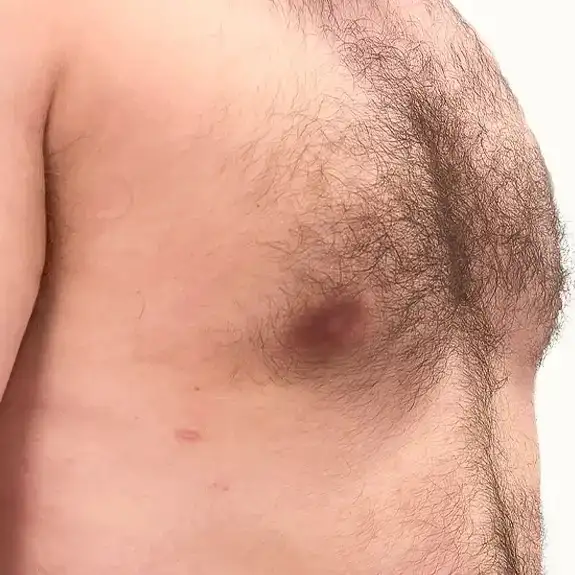Gynecomastia: Reduction of male breast enlargement
From 50€/month
Surgery duration
60 minutes
Anesthesia
General
Postoperative Rest
No rest required
Visible Effects
Immediately
Recovery
1 week
Results
Life-long
We are not a franchise
We have our own medical team
What is gynecomastia?
Gynecomastia is a medical condition where there is abnormal growth of glandular breast tissue in men, leading to a female-like breast appearance. This condition can affect one or both breasts and can occur in children, teenagers, and adult men. Although it is not a serious physical health risk, gynecomastia can have a significant impact on self-esteem and self-confidence. It can also cause physical discomfort, such as heightened sensitivity or pain in the breast area.
How is a gynecomastia procedure performed?
The procedure is performed in several stages. Initially, the surgeon conducts a thorough evaluation to determine the amount of tissue that needs to be removed. Then, the areas for incision are marked. The surgery typically lasts between 1 and 2 hours, depending on the case’s complexity.
- Incision and Tissue Removal: Discreet incisions are made around the areola or in the armpit, where scars are less visible. Through these incisions, the surgeon removes excess breast tissue. If needed, liposuction is also performed to remove additional fat.
- Skin Repositioning: In some cases, excess skin is removed to achieve a firmer, more natural chest contour.
- Closure of Incisions: The incisions are closed using fine sutures to minimize scarring, and dressings are applied to protect the treated area during recovery.
Glandular gynecomastia
This type of breast enlargement is mainly due to the growth of glandular breast tissue. It is often linked to a hormonal imbalance, where estrogen (female hormone) levels exceed testosterone. This form typically presents with firm, dense tissue around the nipple. The most effective treatment is subcutaneous mastectomy, which removes the glandular tissue.
Pseudo gynecomastia
Pseudo gynecomastia is the result of excessive fat accumulation in the pectoral area rather than the growth of glandular tissue, and it is commonly seen in overweight individuals. The chest is usually softer and not associated with hormonal imbalances. Treatment generally involves weight loss, physical exercise, and, in some cases, liposuction to contour the chest and remove localized fat.
Mixed gynecomastia
This is the most common type, combining both glandular tissue and fat in the chest. Treatment typically involves a combination of surgical techniques, such as subcutaneous mastectomy to remove the glandular tissue and liposuction to eliminate excess fat. This approach achieves a more natural and balanced result.
Before and after photos of male gynecomastia
Gynecomastia


Gynecomastia


Gynecomastia


Who is a good candidate for gynecomastia surgery?
Gynecomastia surgery is suitable for men of all ages who experience abnormal enlargement of the breast glands and wish to correct it. Ideal candidates include:
- Men in good overall health.
- Individuals with realistic expectations about the surgery’s results.
- Men who feel discomfort or embarrassment due to enlarged breasts.
- Individuals who have not been able to reduce breast tissue through other treatments or exercise.
Preoperative tests for gynecomastia surgery
Before the surgery, a series of tests are required to ensure the patient is in optimal condition for the procedure. These tests typically include:
- Blood tests to evaluate clotting and other basic health parameters.
- A comprehensive medical evaluation to rule out any underlying conditions that could impact the surgery.
- In some cases, a breast screening (mammogram) or ultrasound may be requested to analyze the breast tissue.

Postoperative care for gynecomastia surgery
Following the procedure, it is essential to follow the surgeon’s recommendations to ensure a quick recovery and optimal results. Postoperative care includes:
- Compression Garment: Wearing a compression garment helps reduce swelling and assists in contouring the chest.
- Activity Restrictions: Avoiding intense physical activity and sun exposure during the first few weeks is critical.
- Follow-Up Appointments: Regular check-ups with the surgeon will help monitor the healing process and ensure everything is progressing as expected.
These instructions are key to ensuring a successful recovery and optimal results.
Eliminates excess glandular tissue
Enhances body proportions
Safe procedure
Lifelong results
How much does gynecomastia cost?
The cost of gynecomastia treatment can vary depending on the complexity of the case and the clinic where the surgery is performed. On average, the price ranges between €3,550 and €4,500. For a more accurate assessment, it is recommended to schedule a consultation with our surgeon.
Factors influencing the price of gynecomastia
- Surgical Technique Used: Prices may vary depending on whether liposuction, glandular tissue excision, or a combination of both techniques is required.
- Degree of Correction: The amount of tissue to be removed directly impacts the final cost.
- Procedure Duration: Longer procedures generally result in higher costs.
- Materials and Equipment Used: The use of advanced technology and specialized equipment may influence the price.
- Postoperative Care: The type of follow-up care and necessary treatments after the surgery (such as compression garments or additional check-ups) also affect the total price.

Where can i undergo gynecomastia surgery?
At EGOS, we offer gynecomastia procedures at several of our locations, making treatment convenient and accessible.
Frequently asked questions about gynecomastia surgery
How long does recovery take?
Recovery time typically takes about 1 to 2 weeks for most patients, with many returning to light activities within a week. Full recovery, including the return to intense physical activity, may take 4 to 6 weeks.
Are the scars visible?
Scars are placed discreetly around the areola or in the armpits, making them less noticeable. Although scars are a natural part of surgery, they typically fade over time and become less visible.
What causes gynecomastia?
Gynecomastia is commonly caused by hormonal imbalances, particularly excess estrogen relative to testosterone. Other factors such as obesity, medications, or underlying health conditions can also contribute.
At what age can I have gynecomastia surgery?
Surgery can be performed on men of any age who have completed puberty. However, it is typically recommended for those whose breast tissue has stabilized and is no longer growin
How is gynecomastia corrected?
Gynecomastia is corrected through surgery, which involves the removal of excess glandular tissue and/or fat from the chest. Liposuction or subcutaneous mastectomy may be performed, depending on the type of gynecomastia.
Is it necessary to repeat the surgery?
In most cases, gynecomastia surgery provides long-lasting results. However, weight gain, aging, or changes in hormone levels may affect the results, and a secondary procedure might be necessary in rare instances.
What are the risk factors associated with gynecomastia surgery?
The risks associated with gynecomastia surgery include:
- Infection: As with any surgery, there is a risk of infection in the treated area if proper post-operative care is not followed.
- Hematomas or bruising: It is common for bruising to appear in the chest area after the procedure.
- Asymmetry: There is a possibility that the results may not be perfectly symmetrical, which could require additional touch-ups.
- Loss of sensitivity: Some individuals may experience temporary or permanent loss of sensation in the nipples or treated area.
- Visible scars: Although techniques are used to minimize scarring, visible marks may remain in some cases.
- Fluid accumulation (seromas): Fluid may accumulate under the skin, which sometimes requires drainage.
- Healing complications: Healing may be slow or problematic, potentially leading to hypertrophic scars or keloids.
Is the result of the surgery permanent?
Yes, the results of gynecomastia surgery are typically permanent. Maintaining a healthy lifestyle and stable weight is essential for preserving the results.
Can I combine gynecomastia surgery with other procedures?
Yes, gynecomastia surgery can often be combined with other cosmetic procedures, such as liposuction or body contouring, depending on the patient’s goals.
Can gynecomastia disappear without surgery?
In some cases, gynecomastia may resolve on its own, particularly during puberty. However, for persistent cases or those causing discomfort, surgery is often the most effective solution.
Does the surgery affect the functionality of the chest?
No, gynecomastia surgery does not affect chest functionality. It does not impact the ability to breastfeed or cause future chest health issues.
What happens if I gain weight after the surgery?
Gaining weight after surgery may impact the chest's appearance. Changes in weight can affect the remaining breast tissue and skin, potentially altering the results.
How can I tell if I have gynecomastia or pseudo-gynecomastia?
Gynecomastia involves the growth of glandular tissue, while pseudo-gynecomastia is caused by excess fat. A physical examination and imaging tests such as a mammogram or ultrasound can help differentiate between the two.
Can gynecomastia affect health beyond aesthetics?
While gynecomastia is not harmful, it can lead to emotional distress, reduced self-esteem, and physical discomfort. It may also cause nipple tenderness or pain.

Our team in gynecomastia treatment

Dr. Tiago Gomes
Throughout my years of experience treating gynecomastia, I have seen how this condition affects not only physical appearance but also the self-esteem of many men. Gynecomastia, which is the abnormal enlargement of breast tissue in men, can cause significant discomfort—especially in those who, despite living a healthy lifestyle and exercising regularly, are unable to reduce the volume in their chest. The most rewarding part for me is seeing how, after surgery, patients feel more confident in themselves and regain trust in their bodies.
More information about Dr. Tiago Gomes
Dr. Santiago Elvira i Barberà
The first thing I explain to my patients when they come in for a gynecomastia consultation is that this condition is not always related to being overweight. In many cases, it results from a hormonal imbalance—often an excess of estrogen in the body or a decrease in testosterone. This imbalance can occur during adolescence but can also affect adult men. The most important thing is to offer a solution tailored to their specific situation, and surgery can be an excellent option when other treatments are ineffective.
More information about Dr. Santiago Elvira i Barberà
Dra. Lorena Vives
One of the most common concerns among my patients is the recovery time after gynecomastia surgery. What I explain to them is that, although there may be some swelling and discomfort during the first few days, most patients can return to their daily activities in about a week. The results are long-lasting, as long as a healthy lifestyle is maintained, allowing them to enjoy both aesthetic and emotional improvement in the long term.La cirugía permite ajustar el tamaño y la forma para que estén en armonía con el resto del pecho, manteniendo siempre un enfoque natural. El resultado final debe ser algo que potencie la confianza de la paciente sin que se sienta que ha perdido su identidad física.
More information about Dra. Lorena Vives
Dr. Edgar Carmona
One of the most important things I always emphasize is that not all cases of chest enlargement in men are true gynecomastia. In some cases, the chest volume may be solely related to excess fat, known as pseudogynecomastia. It is essential to make an accurate diagnosis through a physical examination and, in some cases, imaging studies to determine whether the enlargement is due to excess glandular tissue, fat, or a combination of both. Only then can we plan the most appropriate treatment.
More information about Dr. Edgar Carmona
Dr. Francisco Mora
One of the most common myths I hear from my patients is that gynecomastia can be resolved with exercise alone. Although an active lifestyle is crucial for maintaining good physical health, the reality is that when the issue involves glandular tissue, exercise alone is not enough. In these cases, surgery is the only effective option to remove the excess breast tissue and restore a more masculine figure. It’s important to debunk these kinds of myths so that men seek professional help instead of feeling frustrated.
More information about Dr. Francisco MoraOur patients say about EGOS
Average rating: 4.9 / 5



